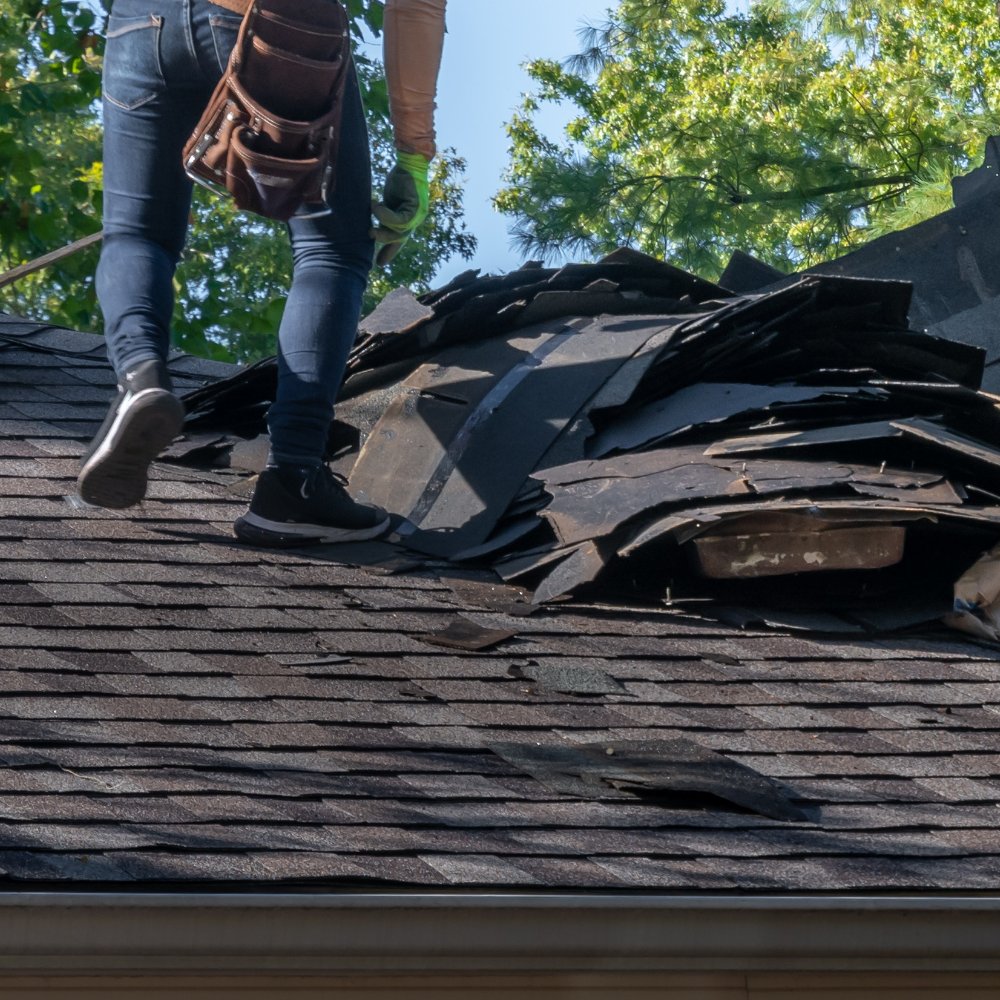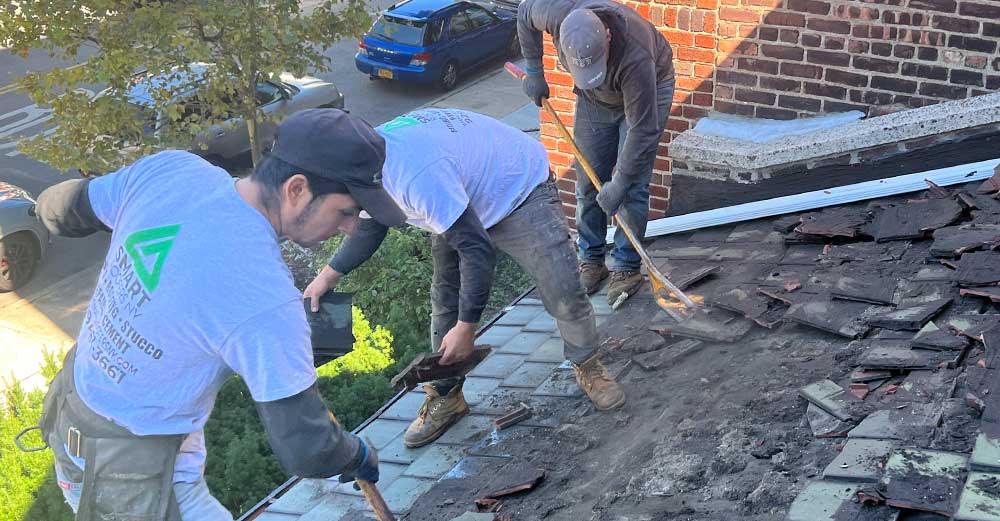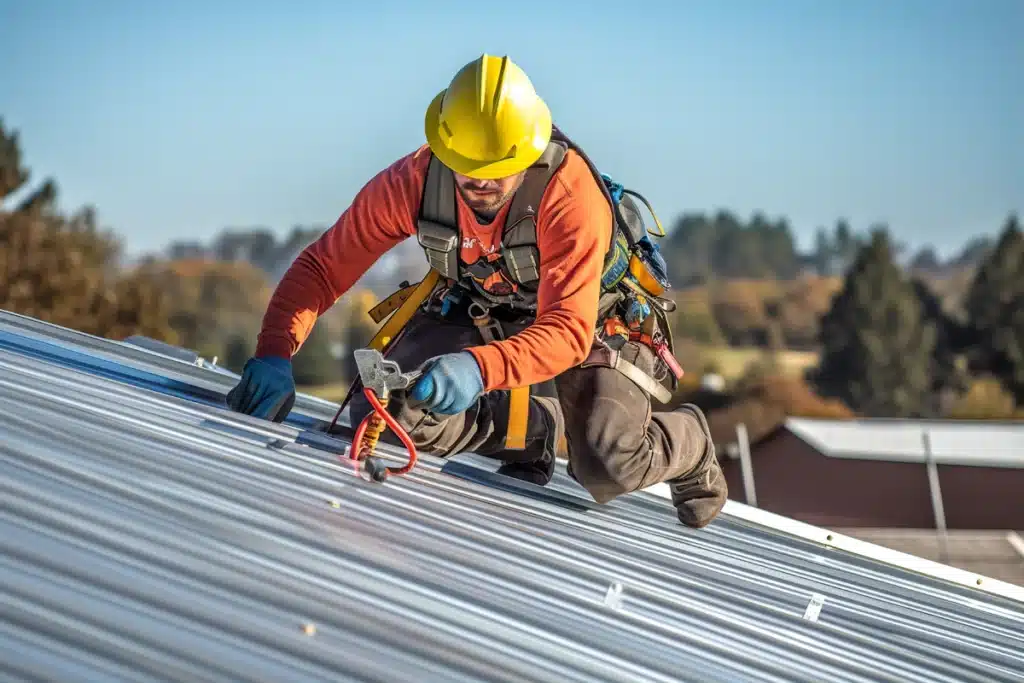Roof Repair Trusted Approaches Even on Old Roofs
Signs You Need Roof Covering Repair Work: Protect Your Investment With These Easy Checks
Understanding the signs that show a need for roofing system repair is critical for guarding your home and investment. Common signs such as missing roof shingles, unanticipated water stains, and granules building up in gutters can recommend underlying concerns that, if left unaddressed, might rise right into even more severe troubles. Additionally, indicators like sagging areas or increased energy expenses can additionally aim to inadequacies or damage. To assure your roof continues to be in top condition and to prevent costly repair work, it is important to recognize these early warning indications and act appropriately. What steps should you take next?
Missing Out On or Harmed Roof Shingles
When evaluating the problem of your roofing, one of one of the most telling signs of potential problems is the visibility of missing or damaged roof shingles. Shingles serve as the initial line of defense against the elements, and their integrity is important for preserving the total health and wellness of your roof covering system - Roof Repair Company. A few missing out on roof shingles might appear small, yet they can result in considerable water seepage, jeopardizing the underlying structure and demanding a lot more comprehensive repairs
Damaged tiles can materialize in numerous means, including curling, splitting, or blistering. Each of these conditions can decrease the performance of your roof covering, allowing wetness to pass through and result in extra severe problems. Roof Repair. It is vital to carry out routine inspections, especially after extreme weather events, as high winds and hefty rain can intensify roof shingles wear and tear
If you recognize missing out on or damaged tiles, it is suggested to resolve these problems without delay. While minor fixings may be manageable for a house owner, comprehensive damage typically necessitates professional treatment. Prompt activity can prevent further complications and protect your financial investment, ensuring the long life and performance of your roof covering.
Water Stains on Ceilings
Water spots on ceilings are usually clear indicators of underlying water damage that calls for instant attention. Determining the source of these stains is important, as they can result from various issues, including roofing leaks or plumbing troubles. Addressing the root cause not only stops more damage but additionally shields the integrity of the home.
Determining Water Damages

When examining for water spots, focus on both the size and shape of the discoloration. Uneven forms may recommend continuous leakages, while more defined areas might suggest previous concerns. In addition, consider the location of the stains; stains near plumbing components or outside wall surfaces might provide ideas concerning prospective resources of the water invasion.
It is likewise crucial to check out the appearance of the ceiling surrounding the stains. Peeling off paint or gurgling drywall can signify extensive wetness exposure, necessitating prompt interest. Routine evaluations and prompt action can aid prevent much more severe water damages, safeguarding both the structural integrity of the home and the investment it represents. Always speak with a professional for a comprehensive assessment if you find water discolorations on your ceilings.
Reasons for Stains
What elements add to the appearance of stains on ceilings? Water stains, frequently manifesting as blemished spots, are mainly brought on by leakages in the roof or pipes systems - Best Roofing Companies In St Louis. When wetness penetrates via roofing products or compromised pipes, it can collect and result in visible staining on ceilings
One typical reason is harmed or missing out on tiles, which can permit rainwater to seep into the attic and, eventually, to the ceilings below. Additionally, inappropriate flashing around chimneys, vents, or skylights can be a significant source of water breach. Plumbing leakages, whether from damaged pipelines or overflowing components, can additionally produce discolorations, especially in areas directly listed below shower rooms or kitchens.

Identifying the source of the stain is vital for reliable repair service. Neglecting these signs can cause a lot more extensive damage, including mold growth and structural weakening, highlighting the value of prompt treatment to shield your financial investment.
Granules in Rain gutters
During regular inspections of your seamless gutters, the visibility of granules can be a significant indication of roof wear and tear. These small, sand-like fragments are commonly discovered externally of asphalt tiles, functioning as a protective layer against UV rays and weathering. Gradually, deterioration can create these granules to remove, causing a series of issues that might compromise the honesty of your roof covering.
If you notice an accumulation of granules in your seamless gutters, it is necessary to take this sign seriously. The loss of granules might expose the underlying asphalt to the elements, enhancing the risk of leakages and water damages. This situation not only jeopardizes your roof covering's lifespan however can additionally bring about costly fixings if not resolved quickly.
To minimize potential damages, it is recommended to evaluate your roofing system routinely, specifically after extreme weather occasions. In addition, involving a specialist roof contractor to assess the problem of your tiles can offer valuable understandings. Early intervention is vital to maintaining your financial investment and ensuring the longevity of your roof. Bear in mind, granules in seamless gutters are not a trivial concern; they indicate the requirement for instant attention and potential repair work.

Sagging Roofing System Areas
Sagging roofing areas can indicate major structural concerns that call for prompt interest (Roofing Service). Visible deformities on the roof's surface area, incorporated with the visibility of water spots inside the home, are important caution signs that should not be forgotten. Addressing these problems without delay can stop additional damages and expensive repair work
Noticeable Roofing Deformities
Exactly how can property owners determine potential issues with their roof coverings? Among the most telling Learn More Here signs shows up roofing system deformities, specifically sagging locations. A drooping roofing system may look like dips or contours, showing underlying architectural problems that might compromise the stability of the entire roof covering system. Property owners need to carry out routine evaluations, looking for any noticeable abnormalities in the roofline.
Numerous factors can add to visible defects, consisting of water damage, inappropriate installation, or the weight of collected snow and particles. If a roof shows up to sag, it may suggest damaged rafters or trusses, which can bring about a lot more severe concerns if left unaddressed. A sagging roof covering not only jeopardizes the architectural stability of the home yet can also lead to pricey repair work expenses if the issue escalates.
If drooping or various other noticeable defects are observed, it is suggested to seek advice from a professional roofer. They can examine the situation, establish the cause of the sagging, and suggest ideal repair work options. Prompt intervention is vital to protect your investment and guarantee the durability of your roof.

Water Stains Inside Home
The visibility of water discolorations inside the home often indicates prospective concerns with the roof, especially in areas where sagging has actually been observed. These spots generally suggest that water is penetrating via the roofing material, which can lead to substantial structural damage if left unaddressed. Sagging roof covering locations may be triggered by a variety of variables, consisting of inadequate assistance, gathered moisture, or the damage of roof materials.
When you see water spots, it is vital to examine the resource of the moisture. Try to find signs of drooping in the roofing system framework, as this can worsen the problem. Commonly, drooping areas can catch water, bring about leakages and more damage. In addition, it is necessary to evaluate the age of the roofing system; older roofs are extra vulnerable to deterioration, increasing the chance of leaks.
Motivate action is needed to alleviate damages. Seek advice from a qualified roof professional to examine the situation and advise suitable repairs. Overlooking water discolorations and sagging can lead to costly repair work and jeopardize the stability of your home. Protect your investment by attending to these indicators prior to they rise right into a lot more serious problems.
Increased Energy Bills
An unanticipated spike in power costs can often signify underlying concerns with your roof. When your roof is compromised, it can lead to considerable air leaks, enabling conditioned air to leave and unconditioned air to penetrate your home. This inefficiency forces your heating and cooling down systems to function harder, resulting in boosted power consumption and higher utility prices.
One usual wrongdoer is harmed or missing shingles, which can reveal your home's interior to the elements. In addition, insufficient insulation due to roof damage can contribute to energy loss. If you notice a regular surge in your power expenses without an equivalent adjustment in use practices, it is crucial to check out potential roof-related concerns.
Regular roofing inspections are essential for identifying troubles before they escalate into costly repair work. Seek noticeable indications of wear, such as drooping areas, splits, or gaps. These might show that your roof covering is no much longer supplying the necessary obstacle versus the components. Resolving these issues quickly can aid restore your home's power efficiency and secure your investment over time. If you presume a trouble, consult a roof covering specialist for a thorough assessment.
Mold or Mildew Development
Mold or mildew growth on your ceiling or walls can be a clear sign of roof-related issues, specifically when dampness infiltrates your home. These fungi prosper in moist environments and can present major wellness threats, including respiratory troubles and allergies. Their presence usually suggests that your roof covering may be jeopardized, allowing water to seep in with leakages or gaps.
To analyze the scenario, look for dark spots or discoloration on surface areas, typically in areas near to the roofline or where water could accumulate (Best Roofing Companies In St Louis). Furthermore, look for any water stains, peeling off paint, or soft spots in your ceiling or walls, which may suggest continuous moisture problems
If you see mold or mildew, it is crucial to act promptly. Not only can continued moisture damage your home's structural integrity, yet it can likewise lead to costly repairs down the line. Involving a professional roofer can assist determine the resource of the problem, whether it's harmed roof shingles, improper ventilation, or other concerns. Normal assessments and upkeep can aid protect against mold growth and secure your financial investment, ensuring a safe and healthy and balanced living environment.
Age of the Roofing system
Reviewing the age of your roof is important in determining its overall condition and potential need for repair services. Most roof covering materials have a details life expectancy, generally varying from 15 to three decades, depending upon the kind of product utilized. Asphalt tiles, for circumstances, typically last concerning twenty years, while steel roof coverings can withstand for 40 years or more. As roof coverings age, they become much more vulnerable to harm from weather, bugs, and other ecological elements.
Normal examinations are necessary for roof coverings older than 15 years. Signs of wear, such as fractured or curling tiles, missing floor tiles, or corrosion on metal surfaces, show that your roof covering might require instant attention. In addition, inner signs like water discolorations on ceilings or walls can signal underlying issues connected to an aging roof covering.
If your roofing system is approaching its anticipated lifespan, consider speaking with a professional contractor for a thorough assessment. They can give insights on repair work alternatives or recommend a replacement if necessary. Aggressive monitoring of an aging roof covering can prevent costly damages to your home and assurance that your investment stays secured.
Often Asked Questions
How Typically Should I Evaluate My Roof Covering for Damage?
Regular roof evaluations are vital for preserving the stability of your home. It is advisable to evaluate your roofing a minimum of twice a year, ideally in the springtime and loss, to determine any prospective concerns early on. Furthermore, after extreme weather occasions, such as heavy storms or hailstorm, a thorough inspection is advised. Attending to small damage quickly can protect against costly repairs and extend the lifespan of your roof system significantly.
Can I Fix My Roof covering Myself?
While it is feasible to repair your roof on your own, it is essential to examine your skills and the complexity of the damages. Small concerns, such as changing a couple of shingles, may be convenient for a DIY enthusiast. Substantial fixings or architectural concerns frequently require specialist experience to ensure safety and compliance with building codes. Always prioritize your security and consider seeking advice from a roof covering professional for substantial damages or if you are unclear about the repairs.
What Are the Common Causes of Roofing System Leaks?
Typical sources of roofing leakages include harmed tiles, which can occur as a result of age or extreme weather, and poorly sealed vents or flashing that may allow water infiltration. Additionally, clogged up rain gutters can result in water backup, causing leaks. Architectural concerns, such as sagging roof coverings or endangered underlayment, likewise add to this problem. Regular assessments and maintenance are crucial to identify these susceptabilities and stop costly damage to your building.
Just How Can I Select a Trusted Professional Roofer?
Choosing a reliable professional roofer entails detailed study and examination. Start by looking for referrals from relied on sources and inspecting online reviews. Confirm the professional's licensing, insurance, and experience in roofing jobs comparable to your own. Request thorough price quotes and compare them for openness. Additionally, inquire concerning warranties and post-installation support. A reliable specialist needs to communicate clearly and demonstrate professionalism throughout the process, ensuring your investment is well protected.
What Is the Ordinary Lifespan of Different Roofing Materials?
The average lifespan of roof products differs significantly. Asphalt shingles typically last 15 to three decades, while steel roofing systems can endure 40 to 70 years. Timber trembles generally have a life expectancy of 20 to 40 years, whereas clay or concrete tiles can surpass 50 years with correct maintenance. Ultimately, artificial roofing materials might provide resilience similar to standard alternatives, typically lasting 30 to half a century. Understanding these lifespans aids in intending for maintenance and replacement.